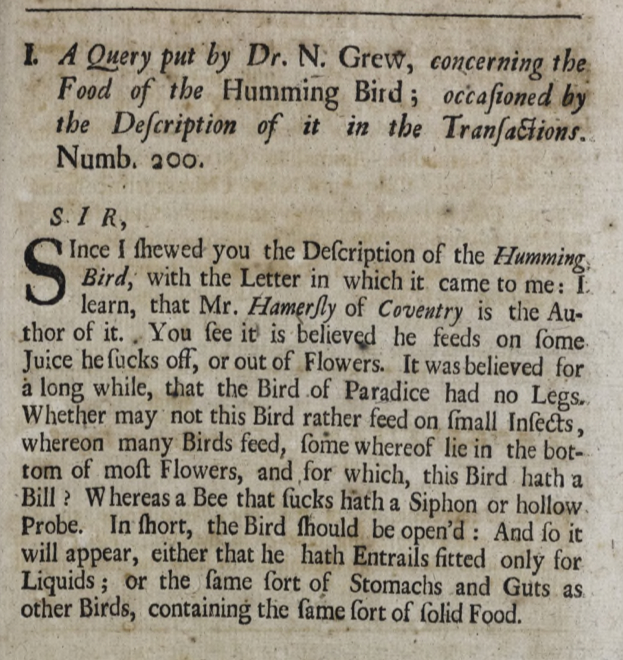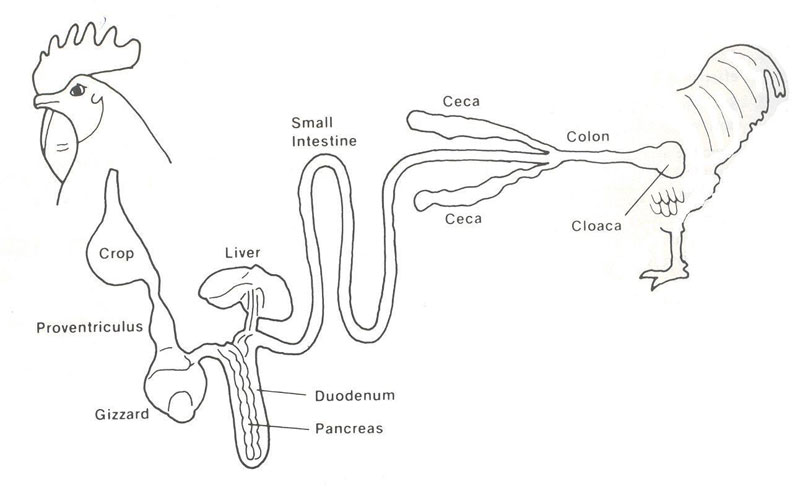A few months ago (10 December 2018), I wrote about the first paper ever published about birds (here)—a description of a hummingbird from Barbados, published by the botanist Nehemiah Grew in May 1693. This publication was in the Royal Society’s Philosophical Transactions, and did not appear until 28 years after scientific publishing began, in 1665. Ornithology did not really become a ‘science’ in England until Ray’s The Ornithology of Francis Willughby was published in English in 1678 [1] but it still took another 15 years before a scientific paper on birds appeared.
Grew also published the second-ever paper about birds when he followed up on his first publication in the July/August 1693 issue of Philosophical Transactions. That second paper is short enough that I can reproduce it here in its entirety:

In that second paper he reports that the observations that he reported on earlier that year were actually made by a Mr Hamersly, and he wonders if the birds really do subsist on nectar, or are actually eating insects on the bottoms of corollas. He must have known that none of the English birds that he would have been familiar with subsisted on nectar alone so it would have seemed anomalous to him that any bird could. He wisely suggests opening up a hummingbird to see if they have different sorts of guts from other birds.
That was a great suggestion—and would have been a revelation—as the stomach of a hummingbird is a specialized structure. At least in the few species whose stomachs have been studied, food enters the hummingbird’s proventriculus (stomach) very close to and on the same plane as where it exits into the duodenum from the ventriculus. Thus the liquid nectar takes a shortcut to the small intestine without passing into the ventriculus. The ventriculus is used to crush insects that the bird eats but really has nothing to offer the nectar. Nutrients are absorbed in the small intestine so the hummingbird digestive systems gets digested nectar to the site of absorption as quickly as possible.


When I was analyzing data for my PhD thesis (on hummingbirds), I lived for a month in a VW camper in the mountains north of Tucson, Arizona. A female Broad-tailed Hummingbird came into our camper regularly to inspect the red plastic plates by the sink. This surprised me because I saw no obvious hummingbird flowers during my frequent walks in the woods. One day, I followed the female back to her nest and often saw her foraging on insects.
We surveyed the woods for 500 m in each of the eight cardinal directions from the nest and found no flowers whatsoever. We also watched the bird during 19 foraging bouts away from the nest and only saw her catching aerial insects and taking prey from spiders’ webs. As far as we were aware at the time (and still), this was the first evidence that hummingbirds could subsist solely on arthropods for a while, and it makes sense, from a nutritional point of view, that they would have to feed animal protein to their nestlings, as otherwise they could not grow.
Hummingbirds continue to be a fascinating group to study but Grew was not the first to publish something about them. That honour goes to the French explorer Jean de Léry who spent 10 months on the coast of Brazil in 1557. de Léry published about his adventures in 1578, with a chapter on the birds he saw, including “une singuliere merveille, et chef-d’oeuvre de petitesse, il n’en faut pas omettre un que les sauvages nomment Gonambuch, de plumage blanchastre et luisant, lequel combien qu’il n’ait pas le corps plus gros qu’un frelon, ou qu’un cerf-volant, triomphe neantmoins de chanter” [2], in other words, a hummingbird.
de Léry’s description could hardly be called ‘scientific’, so the first description of a hummingbird—in fact of 9 species—that is both accurate and scientifically interesting was not published until almost a century later, in 1648. These descriptions appear in Georg Marcgrave‘s section of Historia naturalis Brasiliae. Marcgrave’s original text is in Latin, and was later translated into French and English [3]. I will post a full account of Macgrave’s findings later this year. In the meantime, here is a picture (from Marcgrave) of one of the species he describes:

SOURCES
- Grew N (1693a) The description of the American tomineius, or hummingbird. Philosophical Transactions 17: 760-761
- Grew N (1693b) A query put by Dr. N. Grew, concerning the food of the Humming Bird; occasioned by the description of it in the transactions. Numb. 200. Philosophical Transactions 17: 815
- Klasing K (1998). Comparative Avian Nutrition. New York: CAB International.
- de Léry J (1578) Histoire d’un voyage fait en la terre du Bresil, autrement dite Amerique. Contenant la navigation, et choses remarquables, veuës sur mer par l’aucteur. Le comportement de Villegagnon en ce pays la. Les mœurs et façons de vivre estranges des Sauvages Ameriquains : avec un colloque de leur langage. Ensemble la description de plusieurs Animaux, Arbres, Herbes, et autres choses singulieres, et du tout inconnues pardeçà: dont on verra les sommaires des chapitres au commencement du livre. Le tout recueilli sur les lieux par Jean de Lery, natif de la Margelle, terre de sainct Sene, au Duché de Bourgongne. La Rochelle ou Genève: Antoine Chuppin. [1611 edition available here]
- de Léry J (1990) History of a Voyage to the Land of Brazil. Translation and introduction by Janet Whatley. Berkeley: University of California Press
- López-Calleja MV, Fernández MJ, Bozinovic F (2003) The integration of energy and nitrogen balance in the hummingbird Sephanoides sephaniodes. Journal of Experimental Biology 206:3349–3359.
- Marcgrave G (1648) Historiae Naturalis Brasiliae, Liber Quintus, Qui agit de Avibus. in Piso et al. (1648)
- Montgomerie RD, Redsell CA (1980) A nesting hummingbird feeding solely on arthropods. Condor 82:463–464.
- Piso W, Hackius F, Laet JD, Marggraf G, Lud. E (1648) Historia naturalis Brasiliaeauspicio et beneficio illustriss. I. Mauriti Com. Nassau illius provinciae et maris summi praefecti adornata: in qua non tantum plantae et animalia, sed et indigenarum morbi, ingenia et mores describuntur et iconibus supra quingentas illustrantur. Leiden: Lugdnum Batavorum, Apud Franciscum Hackium, et Amstelodami apud L. Elzevirium. [available here]
- Ray J (1678) The Ornithology of Francis Willughby. London: John Martyn.
Footnotes
- published in English in 1678: it was first published in Latin in 1676
- quotation from de Léry: (1578) which I translate as “But for a singular marvel, and masterpiece of smallness, I must not omit one that the savages call Gonambuch, with whitish and shiny plumage, which has a body no bigger than a hornet, or a beetle, nevertheless triumphs to sing”. Whatley’s (1990) translation of this passage is slightly different but the details are the same.
- translated into French and English: while I studied both French and latin for 5 years at school, my Latin is rustier from lack of use (!). I have not located the French and English translations in a library or on the web.
IMAGES: chicken digestive system from Wikipedia; Grew paper from Biodiversity heritage Library; Broad-tailed hummingbird photo by Bill Ratcliff from Wikimedia Commons
Fascinating info on the hummingbird digestive tract! I’m going to have to go and check up on our African sunbirds now. I’m going to “. . open up a (sun)bird to see if they have different sorts of guts from other birds” – !! In print, though, no sunbirds will be harmed by this amateur!
I have read that all nectarivores have similar stomachs but I cannot find any papers that explicitly look at this, nor can I find anything in the primary literature on hummingbird stomachs. The structure that I mentioned is described in a couple of other papers and in the textbook by Klasing (though I have not seen that myself). When I gdt some free time I will look into this in more depth.
-/~~~~/*.
wt., 7 maj 2019 18:45: History of Ornithology napisał(a): > > Bob Montgomerie commented: “I have read that all nectarivores have similar stomachs but I cannot find any papers that explicitly look at this, nor can I find anything in the primary literature on hummingbird stomachs. The structure that I mentioned is described in a couple of other ” >
Really interesting stuff. Have you found a translation of Macgrave’s findings?
Thanks
No, I am afraid not. In the new year (2020) I will be doing some archive work at the McGill Library in Montraal where they do have a copy of the original Marcgrave book, in Latin,. I will make a stab at translating the relevant pages then.